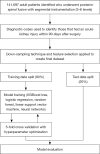Machine learning approach to predict acute kidney injury among patients undergoing multi-level spinal posterior instrumented fusion
- PMID: 39399076
- PMCID: PMC11467292
- DOI: 10.21037/jss-24-15
Machine learning approach to predict acute kidney injury among patients undergoing multi-level spinal posterior instrumented fusion
Abstract
Background: Acute kidney injury (AKI) after spinal fusion is a significant morbidity that can lead to poor post-surgical outcomes. Identifying AKI risk factors and developing a risk model can raise surgeons' awareness and allow them to take actions to mitigate the risks. The objective of the current study is to develop machine learning (ML) models to assess patient risk factors predisposing to AKI after posterior spinal instrumented fusion.
Methods: Data was collected from the IBM MarketScan Database (2009-2021) for patients >18 years old who underwent spinal fusion with posterior instrumentation (3-6 levels). AKI incidence (defined by the International Classification of Diseases codes) was recorded 90-day post-surgery. Risk factors for AKI were investigated and compared through several ML models including logistic regression, linear support vector machine (LSVM), random forest, extreme gradient boosting (XGBoost), and neural networks.
Results: Among the 141,697 patients who underwent fusion with posterior instrumentation (3-6 levels), the overall rate of 90-day AKI was 2.96%. We discovered that the logistic regression model and LSVM demonstrated the best predictions with area under the curve (AUC) values of 0.75. The most important AKI prediction features included chronic renal disease, hypertension, diabetes mellitus ± complications, older age (>50 years old), and congestive heart failure. Patients who did not have these five key risk factors had a 90-day AKI rate of 0.29%. Patients who had an increasing number of key risk factors subsequently had higher risks of postoperative AKI.
Conclusions: The analysis of the data with different ML models identified 5 key variables that are most closely associated with AKI: chronic renal disease, hypertension, diabetes mellitus ± complications, older age (>50 years old), and congestive heart failure. These variables constitute a simple risk calculator with additive odds ratio ranging from 3.38 (1 risk factor) to 91.10 (5 risk factors) over 90 days after posterior spinal fusion surgery. These findings can help surgeons risk-stratify their patients for AKI risk, and potentially guide post-operative monitoring and medical management.
Keywords: Spinal fusion; acute kidney injury (AKI); posterior spinal fusion surgery; risk calculator; risk factors.
2024 AME Publishing Company. All rights reserved.
Conflict of interest statement
Conflicts of Interest: All authors have completed the ICMJE uniform disclosure form (available at https://jss.amegroups.com/article/view/10.21037/jss-24-15/coif). The authors have no conflicts of interest to declare.
Figures
Similar articles
-
Machine learning approach to predict venous thromboembolism among patients undergoing multi-level spinal posterior instrumented fusion.J Spine Surg. 2024 Jun 21;10(2):214-223. doi: 10.21037/jss-24-8. Epub 2024 Jun 17. J Spine Surg. 2024. PMID: 38974487 Free PMC article.
-
[Comparison of machine learning and Logistic regression model in predicting acute kidney injury after cardiac surgery: data analysis based on MIMIC-III database].Zhonghua Wei Zhong Bing Ji Jiu Yi Xue. 2022 Nov;34(11):1188-1193. doi: 10.3760/cma.j.cn121430-20210223-00279. Zhonghua Wei Zhong Bing Ji Jiu Yi Xue. 2022. PMID: 36567564 Chinese.
-
Machine Learning-Based Prediction of Acute Kidney Injury Following Pediatric Cardiac Surgery: Model Development and Validation Study.J Med Internet Res. 2023 Jan 5;25:e41142. doi: 10.2196/41142. J Med Internet Res. 2023. PMID: 36603200 Free PMC article.
-
Machine learning in predicting cardiac surgery-associated acute kidney injury: A systemic review and meta-analysis.Front Cardiovasc Med. 2022 Sep 15;9:951881. doi: 10.3389/fcvm.2022.951881. eCollection 2022. Front Cardiovasc Med. 2022. PMID: 36186995 Free PMC article.
-
Predicting renal function recovery and short-term reversibility among acute kidney injury patients in the ICU: comparison of machine learning methods and conventional regression.Ren Fail. 2022 Dec;44(1):1326-1337. doi: 10.1080/0886022X.2022.2107542. Ren Fail. 2022. PMID: 35930309 Free PMC article. Review.
References
-
- Goyal A, Daneshpajouhnejad P, Hashmi M, et al. Acute Kidney Injury. Treasure Island (FL): StatPearls Publishing; 2024. - PubMed
LinkOut - more resources
Full Text Sources


